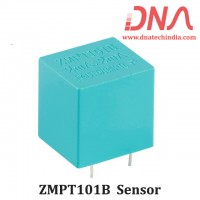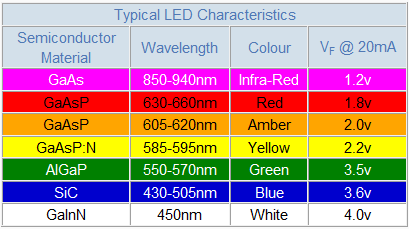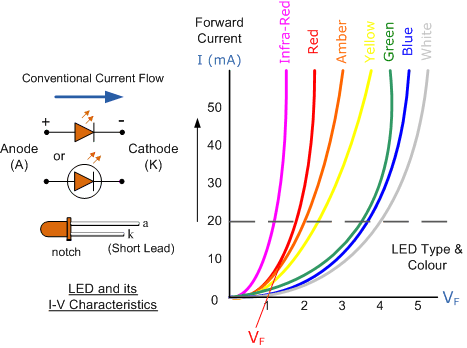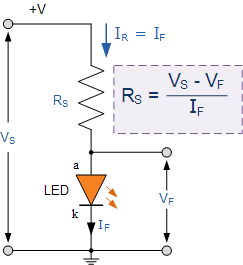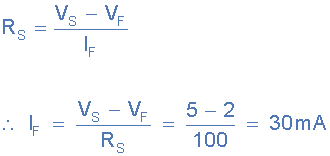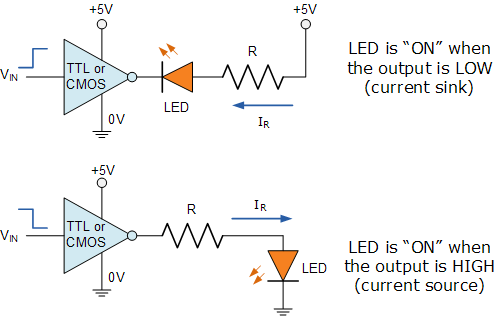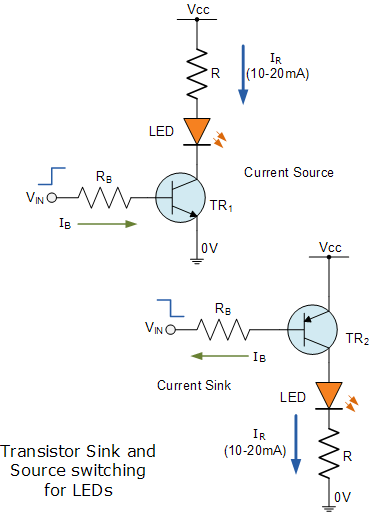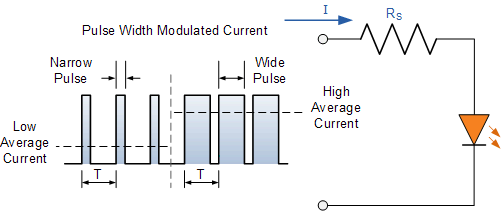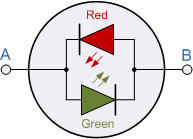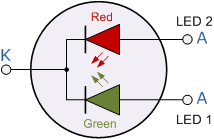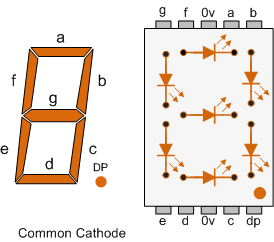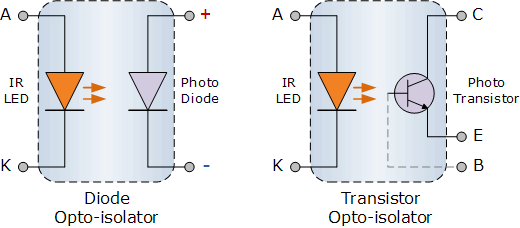Light Emitting Diodes |
||||||||||||||||||||||
|
Light Emitting Diodes or LED´s, are among the most widely used of all the different types of semiconductor diodes available today. They are the most visible type of diode, that emit a fairly narrow bandwidth of either visible light at different coloured wavelengths, invisible infra-red light for remote controls or laser type light when a forward current is passed through them. A "Light Emitting Diode" or LED as it is more commonly called, is basically just a specialised type of PN junction diode, made from a very thin layer of fairly heavily doped semiconductor material. When the diode is forward biased, electrons from the semiconductors conduction band recombine with holes from the valence band releasing sufficient energy to produce photons which emit a monochromatic (single colour) of light. Because of this thin layer a reasonable number of these photons can leave the junction and radiate away producing a coloured light output. Then we can say that when operated in a forward biased direction Light Emitting Diodes are semiconductor devices that convert electrical energy into light energy. |
||||||||||||||||||||||
The construction of a light emitting diode is very different from that of a normal signal diode. The PN junction of an LED is surrounded by a transparent, hard plastic epoxy resign hemispherical shaped shell or body which protects the LED from both vibration and shock. Surprisingly, an LED junction does not actually emit that much light so the epoxy resin body is constructed in such a way that the photons of light emitted by the junction are reflected away from the surrounding substrate base to which the diode is attached and are focused upwards through the domed top of the LED, which itself acts like a lens concentrating the amount of light. This is why the emitted light appears to be brightest at the top of the LED. |
||||||||||||||||||||||
|
However, not all LEDs are made with a hemispherical shaped dome for their epoxy shell. Some LEDs have a rectangular or cylindrical shaped construction that has a flat surface on top. Also, nearly all LEDs have their cathode, (K) terminal identified by either a notch or flat spot on the body, or by one of the leads being shorter than the other, (the Anode, A). |
||||||||||||||||||||||
|
Unlike normal incandescent lamps and bulbs which generate large amounts of heat when illuminated, the light emitting diode produces a "cold" generation of light which leads to high efficiencies than the normal "light bulb" because most of the generated energy radiates away within the visible spectrum. Because LEDs are solid-state devices, they can be extremely small and durable and provide much longer lamp life than normal light sources. |
||||||||||||||||||||||
|
|
||||||||||||||||||||||
Light Emitting Diode Colours |
||||||||||||||||||||||
|
So how does a light emitting diode get its colour. Unlike normal signal diodes which are made for detection or power rectification, and which are made from either Germanium or Silicon semiconductor materials, Light Emitting Diodes are made from exotic semiconductor compounds such as Gallium Arsenide (GaAs), Gallium Phosphide (GaP), Gallium Arsenide Phosphide (GaAsP), Silicon Carbide (SiC) or Gallium Indium Nitride (GaInN) all mixed together at different ratios to produce a distinct wavelength of colour. Different LED compounds emit light in specific regions of the visible light spectrum and therefore produce different intensity levels. The exact choice of the semiconductor material used will determine the overall wavelength of the photon light emissions and therefore the resulting colour of the light emitted. |
||||||||||||||||||||||
Thus, the actual colour of a light emitting diode is determined by the wavelength of the light emitted, which inturn is determined by the actual semiconductor compound used in forming the PN junction during manufacture and NOT by the colouring of the LEDs plastic body although these are slightly coloured to both enhance the light and indicate its colour when its not be used. Light emitting diodes are available in a wide range of colours with the most common being RED, AMBER, YELLOW and GREEN and are thus widely used as visual indicators and as moving light displays. |
||||||||||||||||||||||
|
Recently developed blue and white coloured LEDs are also available but these tend to be much more expensive than the normal standard colours due to the production costs of mixing together two or more complementary colours at an exact ratio within the semiconductor compound and also by injecting nitrogen atoms into the crystal structure during the doping process. |
||||||||||||||||||||||
|
From the table above we can see that the main P-type dopant used in the manufacture of Light Emitting Diodes is Gallium (Ga, atomic number 31) and that the main N-type dopant used is Arsenic (As, atomic number 31) giving the resulting compound of Gallium Arsenide (GaAs) crystal structure. The problem with using Gallium Arsenide on its own as the semiconductor compound is that it radiates large amounts of low brightness infra-red radiation (850nm-940nm approx.) from its junction when a forward current is flowing through it. This infra-red light is ok for television remote controls but not very useful if we want to use the LED as an indicating light. But by adding Phosphorus (P, atomic number 15), as a third dopant the overall wavelength of the emitted radiation is reduced to below 680nm giving visible red light to the human eye. Further refinements in the doping process of the PN junction have resulted in a range of colours spanning the spectrum of visible light as we have seen above as well as infra-red and ultra-violet wavelengths. |
||||||||||||||||||||||
|
By mixing together a variety of semiconductor, metal and gas compounds the following list of LEDs can be produced. |
||||||||||||||||||||||
|
|
||||||||||||||||||||||
|
Like conventional PN junction diodes, LEDs are current-dependent devices with its forward voltage drop VF, depending on the semiconductor compound (its light colour) and on the forward biased LED current. The point where conduction begins and light is produced is about 1.2V for a standard red LED to about 3.6V for a blue LED. The exact voltage drop will of course depend on the manufacturer because of the different dopant materials and wavelengths used. The voltage drop across the LED at a particular current value, for example 20mA, will also depend on the initial conduction VF point. As an LED is effectively a diode, its forward current to voltage characteristics curves can be plotted for each diode colour as shown below. |
||||||||||||||||||||||
|
|
||||||||||||||||||||||
Light Emitting Diodes I-V Characteristics |
||||||||||||||||||||||
|
|
||||||||||||||||||||||
|
Light Emitting Diode (LED) Schematic symbol and its I-V Characteristics Curves showing the different colours available |
||||||||||||||||||||||
|
Before a light emitting diode can "emit" any form of light it needs a current to flow through it, as it is a current dependant device with their light output intensity being directly proportional to the forward current flowing through the LED. As the LED is to be connected in a forward bias condition across a power supply it should be current limited using a series resistor to protect it from excessive current flow. Never connect an LED directly to a battery or power supply as it will be destroyed almost instantly because too much current will pass through and burn it out. |
||||||||||||||||||||||
|
From the table above we can see that each LED has its own forward voltage drop across the PN junction and this parameter which is determined by the semiconductor material used, is the forward voltage drop for a specified amount of forward conduction current, typically for a forward current of 20mA. In most cases LEDs are operated from a low voltage DC supply, with a series resistor, RS used to limit the forward current to a safe value from say 5mA for a simple LED indicator to 30mA or more where a high brightness light output is needed. |
||||||||||||||||||||||
|
|
||||||||||||||||||||||
LED Series Resistance |
||||||||||||||||||||||
|
The series resistor value RS is calculated by simply using Ohm´s Law, by knowing the required forward current IF of the LED, the supply voltage VS across the combination and the expected forward voltage drop of the LED, VF at the required current level, the current limiting resistor is calculated as: |
||||||||||||||||||||||
|
|
||||||||||||||||||||||
LED Series Resistor Circuit |
||||||||||||||||||||||
|
|
||||||||||||||||||||||
|
|
||||||||||||||||||||||
Example No1 |
||||||||||||||||||||||
|
An amber coloured LED with a forward volt drop of 2 volts is to be connected to a 5.0v stabilised DC power supply. Using the circuit above calculate the value of the series resistor required to limit the forward current to less than 10mA. Also calculate the current flowing through the diode if a 100Ω series resistor is used instead of the calculated first. |
||||||||||||||||||||||
|
1). series resistor value at 10mA. |
||||||||||||||||||||||
|
|
||||||||||||||||||||||
|
2). with a 100Ω series resistor. |
||||||||||||||||||||||
|
|
||||||||||||||||||||||
|
We remember from the Resistors tutorials, that resistors come in standard preferred values. Our first calculation above shows to limit the current flowing through the LED to 10mA exactly, we would require a 300Ω resistor. In the E12 series of resistors there is no 300Ω resistor so we would need to choose the next highest value, which is 330Ω. A quick re-calculation shows the new forward current value is now 9.1mA, and this is ok. |
||||||||||||||||||||||
|
|
||||||||||||||||||||||
LED Driver Circuits |
||||||||||||||||||||||
|
Now that we know what is an LED, we need some way of controlling it by switching it "ON" and "OFF". The output stages of both TTL and CMOS logic gates can both source and sink useful amounts of current therefore can be used to drive an LED. Normal integrated circuits (ICs) have an output drive current of up to 50mA in the sink mode configuration, but have an internally limited output current of about 30mA in the source mode configuration. Either way the LED current must be limited to a safe value using a series resistor as we have already seen. Below are some examples of driving light emitting diodes using inverting ICs but the idea is the same for any type of integrated circuit output whether combinational or sequential. |
||||||||||||||||||||||
|
|
||||||||||||||||||||||
IC Driver Circuit |
||||||||||||||||||||||
|
|
||||||||||||||||||||||
|
If more than one LED requires driving at the same time, such as in large LED arrays, or the load current is to high for the integrated circuit or we may just want to use discrete components instead of ICs, then an alternative way of driving the LEDs using either bipolar NPN or PNP transistors as switches is given below. Again as before, a series resistor, RS is required to limit the LED current. |
||||||||||||||||||||||
|
|
||||||||||||||||||||||
Transistor Driver Circuit |
||||||||||||||||||||||
|
|
||||||||||||||||||||||
| The brightness of a light emitting diode cannot be controlled by simply varying the current flowing through it. Allowing more current to flow through the LED will make it glow brighter but will also cause it to dissipate more heat. LEDs are designed to produce a set amount of light operating at a specific forward current ranging from about 10 to 20mA. In situations were power savings are important, less current may be possible. However, reducing the current to below say 5mA may dim its light output too much or even turn the LED "OFF" completely. A much better way to control the brightness of LEDs is to use a control process known as "Pulse Width Modulation" or PWM, in which the LED is repeatedly turned "ON" and "OFF" at varying frequencies depending upon the required light intensity. | ||||||||||||||||||||||
|
|
||||||||||||||||||||||
LED Light Intensity using PWM |
||||||||||||||||||||||
|
|
||||||||||||||||||||||
|
When higher light outputs are required, a pulse width modulated current with a fairly short duty cycle ("ON-OFF" Ratio) allows the diode current and therefore the output light intensity to be increased significantly during the actual pulses, while still keeping the LEDs "average current level" and power dissipation within safe limits. This "ON-OFF" flashing condition does not affect what is seen as the human eyes fills in the gaps between the "ON" and "OFF" light pulses, providing the pulse frequency is high enough, making it appear as a continuous light output. So pulses at a frequency of 100Hz or more actually appear brighter to the eye than a continuous light of the same average intensity. |
||||||||||||||||||||||
|
|
||||||||||||||||||||||
Multi-coloured Light Emitting Diode |
||||||||||||||||||||||
|
LEDs are available in a wide range of shapes, colours and various sizes with different light output intensities available, with the most common (and cheapest to produce) being the standard 5mm Red Gallium Arsenide Phosphide (GaAsP) LED. LED's are also available in various "packages" arranged to produce both letters and numbers with the most common being that of the "seven segment display" arrangement. Nowadays, full colour flat screen LED displays are available with a large number of dedicated ICs available for driving the displays directly. Most light emitting diodes produce just a single output of coloured light however, multi-coloured LEDs are now available that can produce a range of different colours from within a single device. Most of these are actually two or three LEDs fabricated within a single package. |
||||||||||||||||||||||
|
|
||||||||||||||||||||||
Bicolour Light Emitting Diodes |
||||||||||||||||||||||
|
A bicolour light emitting diode has two LEDs chips connected together in "inverse parallel" (one forwards, one backwards) combined in one single package. Bicolour LEDs can produce any one of three colours for example, a red colour is emitted when the device is connected with current flowing in one direction and a green colour is emitted when it is biased in the other direction. This type of bi-directional arrangement is useful for giving polarity indication, for example, the correct connection of batteries or power supplies etc. Also, a bi-directional current produces both colours mixed together as the two LEDs would take it in turn to illuminate if the device was connected (via a suitable resistor) to a low voltage, low frequency AC supply. |
||||||||||||||||||||||
|
|
||||||||||||||||||||||
A Bicolour LED |
||||||||||||||||||||||
|
|
||||||||||||||||||||||
|
|
||||||||||||||||||||||
Tricolour Light Emitting Diodes |
||||||||||||||||||||||
|
The most popular type of tricolour LED comprises of a single Red and a Green LED combined in one package with their cathode terminals connected together producing a three terminal device. They are called tricolour LEDs because they can give out a single red or a green colour by turning "ON" only one LED at a time. They can also generate additional shades of colours (the third colour) such as Orange or Yellow by turning "ON" the two LEDs in different ratios of forward current as shown in the table thereby generating 4 different colours from just two diode junctions. |
||||||||||||||||||||||
|
|
||||||||||||||||||||||
A Multi or Tricolour LED |
||||||||||||||||||||||
|
||||||||||||||||||||||
|
|
||||||||||||||||||||||
LED Displays |
||||||||||||||||||||||
|
As well as individual colour or multi-colour LEDs, several light emitting diodes can be combined together within a single package to produce displays such as bargraphs, strips, arrays and seven segment displays. A seven segment LED display provides a very convenient way when decoded properly of displaying information or digital data in the form of numbers, letters or even alpha-numerical characters and as their name suggests, they consist of seven individual LEDs (the segments), within one single display package. |
||||||||||||||||||||||
|
In order to produce the required numbers or characters from 0 to 9 and A to F respectively, on the display the correct combination of LED segments need to be illuminated. A standard seven segment LED display generally has eight input connections, one for each LED segment and one that acts as a common terminal or connection for all the internal segments. |
||||||||||||||||||||||
|
The Common Cathode Display (CCD) - In the common cathode display, all the cathode connections of the LEDs are joined together and the individual segments are illuminated by application of a HIGH, logic "1" signal. |
||||||||||||||||||||||
|
The Common Anode Display (CAD) - In the common anode display, all the anode connections of the LEDs are joined together and the individual segments are illuminated by connecting the terminals to a LOW, logic "0" signal. |
||||||||||||||||||||||
|
|
||||||||||||||||||||||
A Typical Seven Segment LED Display |
||||||||||||||||||||||
|
|
||||||||||||||||||||||
|
|
||||||||||||||||||||||
Opto-coupler |
||||||||||||||||||||||
|
Finally, another useful application of light emitting diodes is Opto-coupling. An opto-coupler or opto-isolator as it is also called, is a single electronic device that consists of a light emitting diode combined with either a photo-diode, photo-transistor or photo-triac to provide an optical signal path between an input connection and an output connection while maintaining electrical isolation between two circuits. An opto-isolator consists of a light proof plastic body that has a typical breakdown voltages between the input (photo-diode) and the output (photo-transistor) circuit of up to 5000 volts. This electrical isolation is especially useful where the signal from a low voltage circuit such as a battery powered circuit, computer or microcontroller, is required to operate or control another external circuit operating at a potentially dangerous mains voltage. |
||||||||||||||||||||||
|
|
||||||||||||||||||||||
Photo-diode and Photo-transistor Opto-couplers |
||||||||||||||||||||||
|
|
||||||||||||||||||||||
|
The two components used in an opto-isolator, an optical transmitter such as an infra-red emitting Gallium Arsenide LED and an optical receiver such as a photo-transistor are closely optically coupled and use light to send signals and/or information between its input and output. This allows information to be transferred between circuits without an electrical connection or common ground potential. Opto-isolators are digital or switching devices, so they transfer either "ON-OFF" control signals or digital data. Analogue signals can be transferred by means of frequency or pulse-width modulation. |
||||||||||||||||||||||
|
|
||||||||||||||||||||||
|
Reproduced with permission from Wayne Storr |
||||||||||||||||||||||


